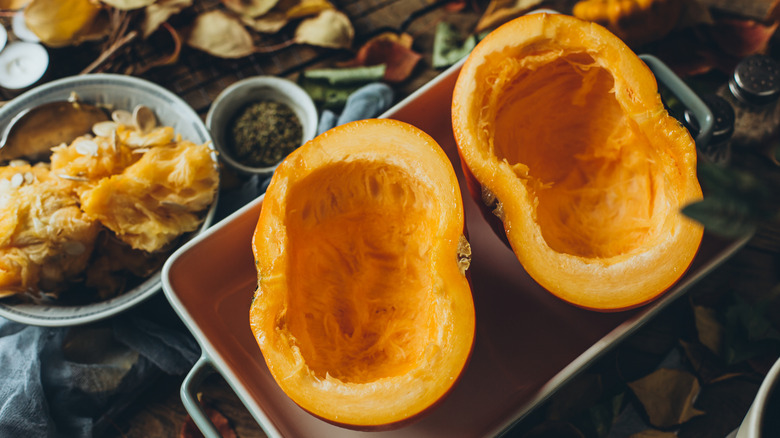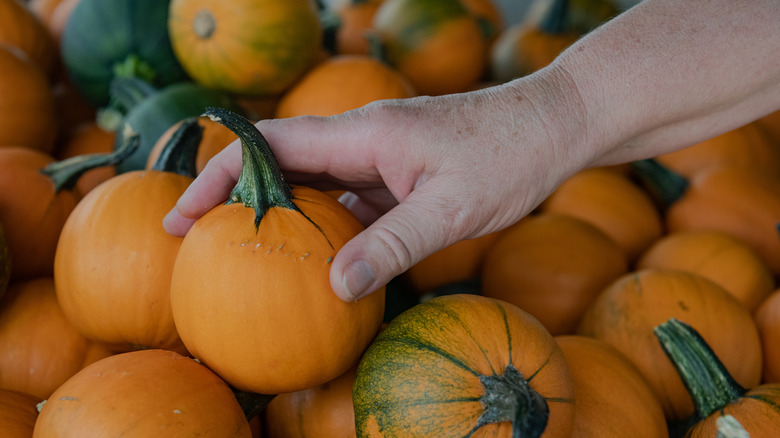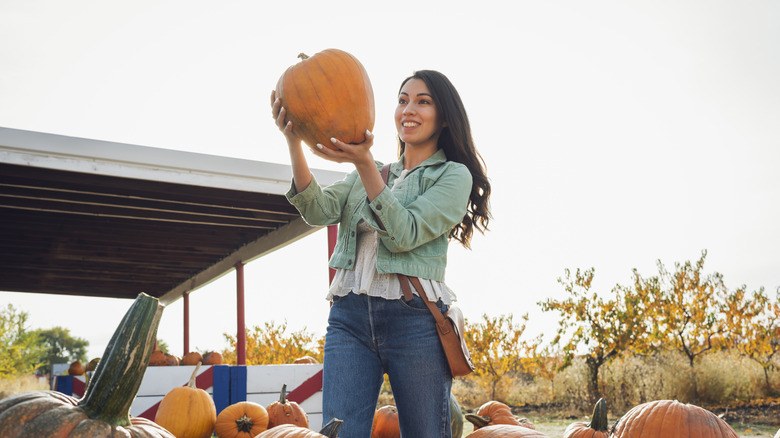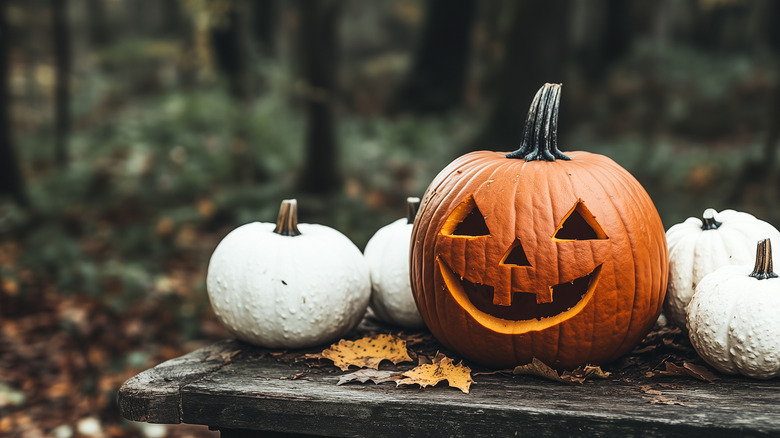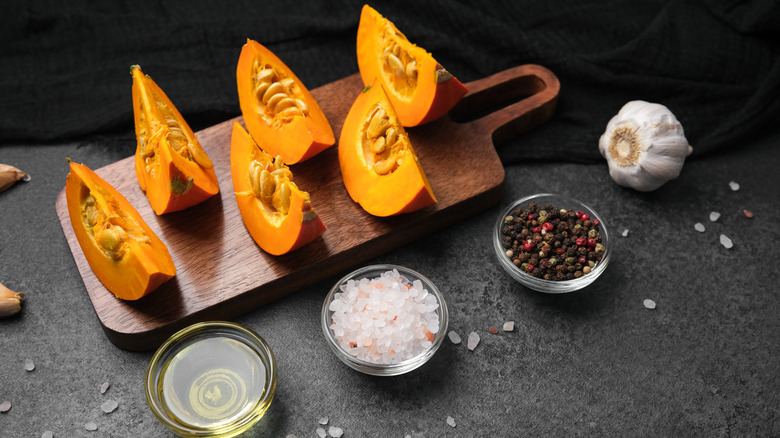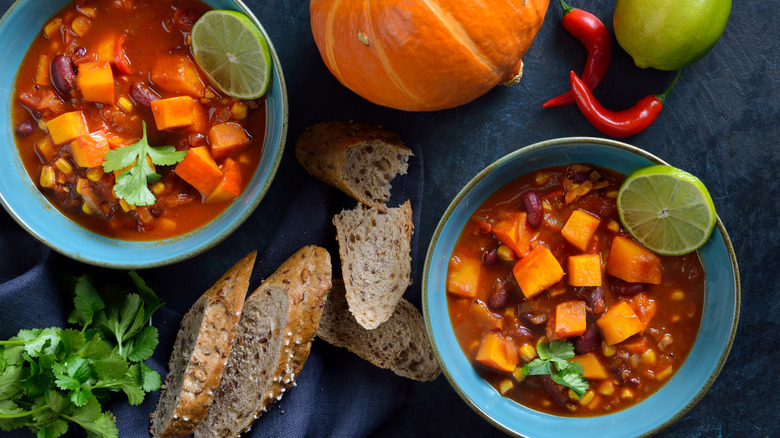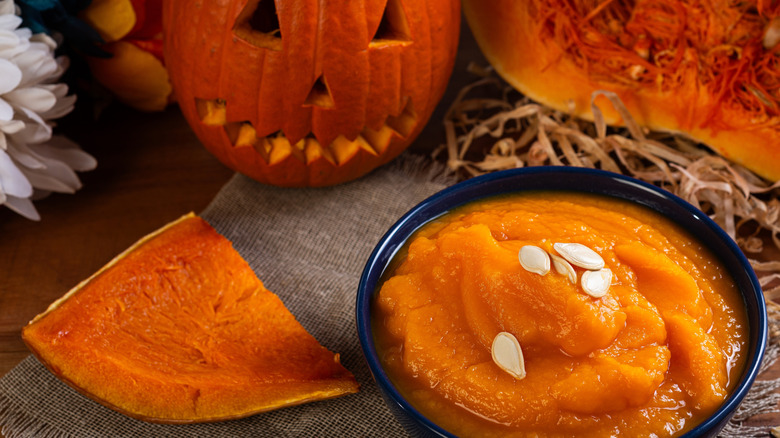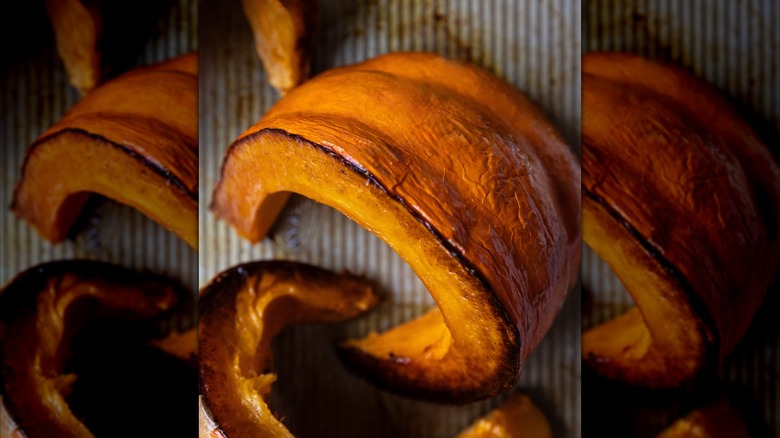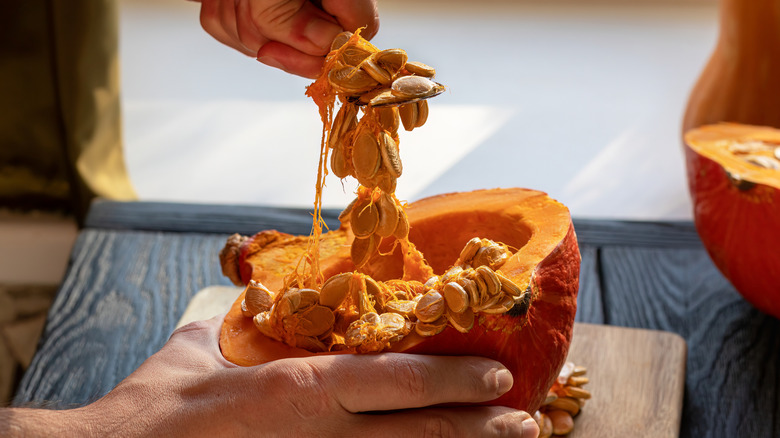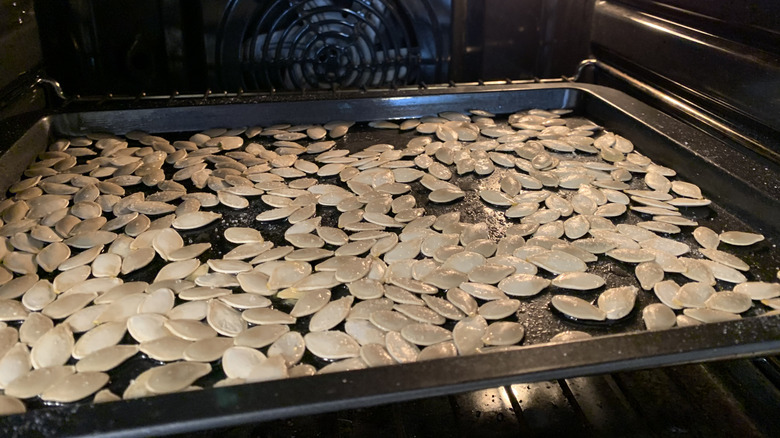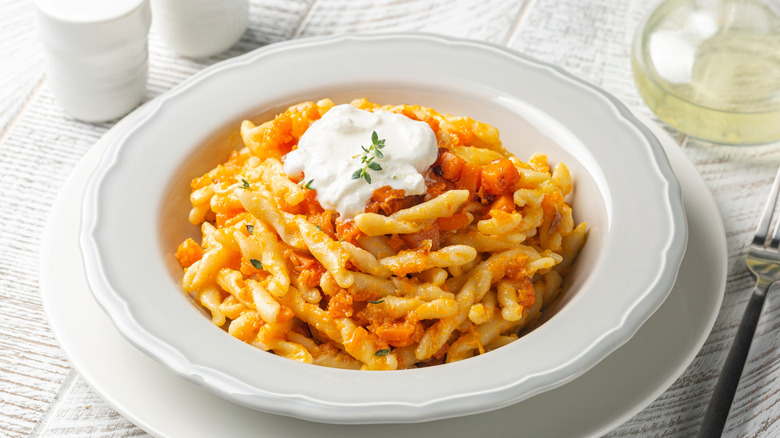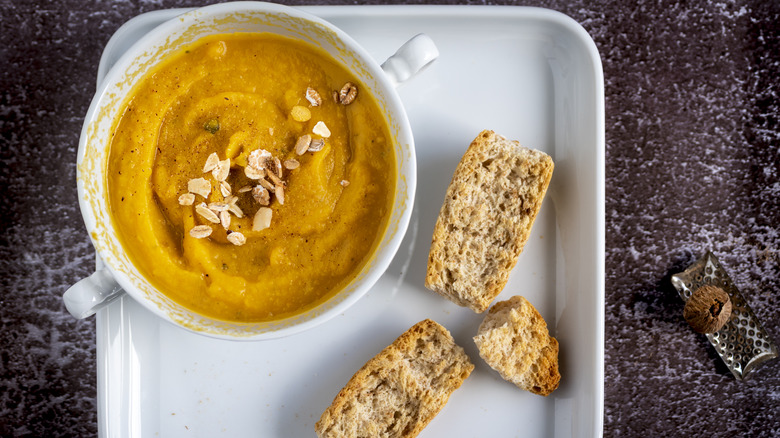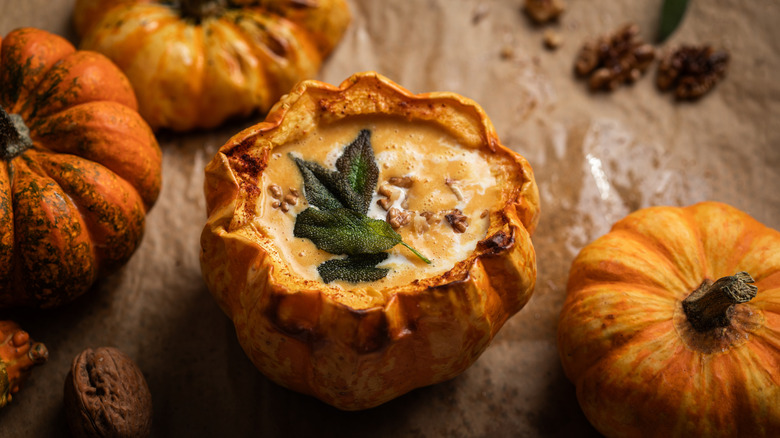12 Mistakes You're Making When Cooking With Pumpkin, According To Chefs
Once September hits, it seems like pumpkin is absolutely everywhere. The pumpkin spice latte has already appeared on the Starbucks menu, usually making its debut in late August, and brands roll out a bevy of pumpkin-flavored products. Pumpkin spice has taken over the world thanks to factors such as its strong connection to the holiday season (versus apples' lackluster showing) and its nostalgic appeal — and we're just along for the ride. Even if you only stop by a single store, you'll find pumpkin shoved into all manner of food, from pumpkin samosas and honey roasted pumpkin ravioli to butternut squash mac & cheese bites and pumpkin butternut squash bisque.
You're probably starting to incorporate pumpkin into your own cooking and baking projects, as well. However, while you may think that cooking with pumpkin is just as easy as picking out a solid-looking gourd from the cardboard bin at the grocery store, or otherwise picking up a good brand of canned pumpkin purée, think again.
We spoke with a handful of chefs to get their insights on the top mistakes that home cooks make when cooking with pumpkin. Turns out, you could be committing some major pumpkin faux pas before you even leave the store.
Picking the wrong pumpkin
As mentioned, you could be making the first big pumpkin mistake while you're still inside the grocery store or farmers market, and that mistake is picking the entirely wrong pumpkin for your purpose. It's important to follow the experts and their advice as to which pumpkin to use for your specific recipe.
For example, chef Felipe Cuevas of Mothers Tacos in Ventura, California, told us about the time when he approached his mother with a Halloween carving pumpkin, hoping to make calabaza en dulce de piloncillo, a Mexican candied pumpkin dish. "When she saw the pumpkin I had bought, she said in Spanish, 'The only thing you're making with this pumpkin is going to be a jack-o-lantern'," he recalled. "She quickly explained that those are too watery and fibrous and they don't work well for the recipe." The chef's mother told him to go back to the market and instead ask for a calabaza de Castilla, sometimes known as cushaw pumpkin or silver-seed gourd, which is native to Mexico and Central America. "This is the traditional pumpkin used for our candied pumpkin dish in Mexico," Cuevas explained, since its firmer flesh makes it "easier to work with when it comes to oven roasting it."
So, before picking up any ol' pumpkin, do some research into the best variety for your particular dish. If a recipe says to use a particular type of pumpkin, don't veer off into other territory, or you may just find your dish's flavor and texture both come out all wrong.
Buying a too-soft pumpkin
Just like you'd typically test the firmness of any produce that you're going to purchase, so should you test the firmness of your pumpkin before placing it in your shopping cart. Alon Shaya, chef and co-founder of Pomegranate Hospitality, recommends looking for a pumpkin that's on the firmer side.
To test pumpkin firmness, press your fingers into the flesh around both the bottom of the pumpkin and around the stem. If you notice any soft spots at all, it's a sign the pumpkin is not fresh. You can also press a fingernail into the pumpkin. If your fingernail penetrates the rind, it means the squash was picked at an inopportune time and will likely decay faster.
Beyond a firm exterior — whether you're picking any variety of pumpkin from the patch or the market bin — watch out for a few other signs that your pumpkin may not be of the highest quality or last all that long. Cracks and splits are a red flag. You can't, though, rely too much on color when picking a specimen of the highest quality, as pumpkins currently come in so many different varieties and hues.
Using your Halloween pumpkin incorrectly
While chef Felipe Cuevas may have not been able to turn his Halloween pumpkin into calabaza en dulce de piloncillo, that doesn't mean that you can't utilize your Halloween pumpkin in the kitchen at all. It's more than just decoration, if you know what you're doing.
According to executive chef Kevin Templeton of barleymash and Hasta Mañana Cantina in San Diego, "You can still use the meat inside [...] Once you've got it cleaned and cut, you can cover the meat in a bit of coconut oil and roast [it] in the oven until golden brown." He also recommends cooking the pumpkin seeds, a tradition he calls his favorite part of Halloween.
From there, what you do with your cooked Halloween pumpkin is up to you. However, if you do plan on making fresh pumpkin purée or roasting it, consider opting for a smaller sugar pie or Cinderella pumpkin for your fall décor display. This will offer you a better flavor and texture versus the heirloom carving pumpkins sold explicitly for making jack-o-lanterns.
Forgetting to add salt
In many cases, you're going to need to add some extra salt to your pumpkin. As executive chef Christian Farrar of Table 20 in Cartersville, Georgia, explained, "Pumpkin needs salt. That's not just a home cook misstep; chefs mess this up, too. A can of pumpkin purée is basically baby food. Whether you're making a pie, ravioli, or something else, you've got to salt it right for it to taste like anything at all."
However, while forgetting to add any salt to your pumpkin is one mistake you could make, the inverse is also true. If you've cooked pumpkin and over-salted it, some may suggest (if the pumpkin is puréed or in soup form rather than, for instance, diced and roasted) adding more, unsalted pumpkin to the mix, to even things out. However, another popular "hack" for remedying an overly salty pumpkin soup is by adding potatoes, which supposedly soak up the salt. This, though, has been proven to only be very minimally effective.
Not putting it in your chili
Pumpkin? In your chili? Yep! If you have a can of pumpkin puree on your hands and you've already had your fill of pumpkin pie, pumpkin roll, pumpkin bisque, and everything else, Christian Farrar recommends stirring it into your chili, saying, "It adds body, blending seamlessly into the tomato and spice flavors, and prevents you from letting that can sit on the shelf until next year."
Adding pumpkin to your chili is just one of the few novel ways to cook with pumpkin this season (and if you do add pumpkin to your chili this fall or later, also consider adding in some chipotle, adobo, ginger, nutmeg, allspice, and cinnamon, for a rich, hearty, cozy flavor profile). Adding pumpkin to macaroni and cheese can create an elevated take on a classic, with extra richness, or combine pumpkin purée with the chicken in your enchiladas.
Have extra roasted pumpkin seeds rather than a can of purée? Place them in your food processor and process them until they're about the consistency of peanut butter, and then add them to your guacamole for a deep, rich nuttiness.
Adding too much water
When discussing his lesson in cooking pumpkin as related to calabaza en dulce de piloncillo, chef Felipe Cuevas also mentioned that it's important to not add too much liquid to pumpkin when you're cooking it. As for calabaza en dulce de piloncillo, he said the pumpkin itself will release liquid, but so will the piloncillo (or Mexican brown sugar).
If you think that you'll just get around this mistake by simply keeping careful watch on how much water or other liquid you're adding to a recipe, it's important to realize that raw pumpkin all on its own is up to 90% water. So if you're adding liquid to your recipe, and the raw pumpkin is releasing water as well during the cooking process, you run the risk of a really soggy and/or watery resulting dish. Luckily, there are a few things you can do to fix watery homemade pumpkin purée, or to ensure your purée doesn't leech too much water into, say, a pastry crust.
Some like to strain their homemade pumpkin puree through cheese cloth overnight. Others try to soak up the moisture using paper towels. However, one of the best ways to remove excess water from a homemade pumpkin purée is to heat it over the stove until the excess moisture evaporates, a process which only takes about 10 minutes.
Overcooking your pumpkin
Chef Felipe Cuevas additionally noted that it can be surprisingly easy to overcook your pumpkin. "If you start seeing too much liquid evaporating [...] it's time to take it out before you lose all the good stuff," he advised. "All ovens are different, and it also depends on the size of the pumpkin."
In general, if you're cooking a small pumpkin with the rind still on for the purposes of making pumpkin purée, you'll know that the pumpkin is done when you can easily poke through both the rind and flesh using a fork. This may take up to an hour, depending on pumpkin size and your oven.
Maybe you're not worried about overcooking, though. Maybe you're more concerned about a long cooking time. If that's you, consider postponing roasting and puréeing your pumpkin to a day when you have greater availability. However, do note that you can save time by always leaving the rind on the pumpkin rather than trying to peel it ahead of roasting. Peeling the hard rind is both laborious and time-consuming, and when you roast the pumpkin with the rind intact, the flesh will practically fall out after cooking.
Neglecting to clean your pumpkin well enough
When breaking down for us how to go about cooking your Halloween pumpkin, chef Kevin Templeton noted that it's a common mistake for home cooks to not clean their pumpkins well enough. "You really have to get all the pulp scraped out," he said. Then, of course, keep your pumpkin seeds for cooking later — but don't toss all those pumpkin guts into the trash immediately.
Even if you're just carving your pumpkin and don't plan on using the flesh to create a purée or roasted pumpkin, there are ways to use leftover pumpkin guts elsewhere. For example, if you purée all that stringy goodness, you'll be left with the base for a face mask; just add honey and face oil, apply, and rinse. You can also freeze the guts and use them as dog treats (other animals that will gladly eat up those pumpkin bits include the neighborhood birds and squirrels, but also domestic chickens, if you have them). You can likewise use the guts along with other vegetable scraps to make a fall-ready veggie stock.
Forgetting to soak your pumpkin seeds
So you picked the right pumpkin. You cleaned it thoroughly. You're roasting it and keeping a careful watch on the oven so it doesn't overcook. Next, you're ready to roast your pumpkin seeds — that should be simple, right? Well, you will need to take an extra step that a lot of people don't think about, said Kevin Templeton.
"The best way to cook them is to clean the seeds as much as you can," he said. "Something most people don't do, but that really helps with baking, is to soak them in salt water for a few hours, drain them well, and place them on a lightly oiled cookie sheet. Sprinkle the seeds with a little more salt and bake [them] in the oven until they're lightly golden. The temperature should be about 350 to 400 degrees Fahrenheit."
Soaking your pumpkin seeds can even help with the messy job of separating the seeds from all the stringy pumpkin innards. Just plop all that goop into a bowl, fill it with water, and then swirl it about a tad with your finger and watch as the seeds float to the top while the pulp sinks. Then, you can use a slotted spoon to scoop up the separated seeds and add them to a new, fresh bowl of salt water for longer soaking, per Templeton's suggestion.
Not getting versatile with your pumpkin
Even with all of the ideas you may have picked up for using your pumpkin thus far, are you really getting creative with this squash? Maybe not. Executive chef James King of Che Vita in Tampa, noted that pumpkin is still often only utilized for pumpkin pie, pumpkin seeds, or carving, with other squashes (maybe butternut or acorn) taking center stage for actual cooking. "Beyond these familiar uses, pumpkin offers a balance of sweet and savory flavors that can be highlighted in a variety of dishes," he said.
King recommended making a simple "zuccamore" pasta (which he translates as "pumpkin love"). All you have to do is add a shallot to melted butter in a medium-hot pan, seasoning with salt and pepper. Cook until fragrant and add thyme. When the shallot is soft, deglaze the pan with white wine and reduce by half. Add cubed pumpkin and more thyme, and simmer until the pumpkin is soft. Remove the thyme and mash most of the pumpkin, leaving about a quarter cubed, for texture, and then add cooked pasta and a little pasta water (add more if the sauce is too thick). Top it with creamy burrata and toasted nuts to serve.
Not pairing sweet pumpkin with savory flavors
Most home cooks buy sweet pumpkins with the express intent of turning them into pie. However, don't overlook the possibilities of pairing sweet pumpkins with savory flavors.
As Ashwin Vilkhu, executive chef at The Kingsway and co-executive chef at Saffron, told us, "When cooking with kabocha squash, which is referred to as 'Japanese pumpkin,' don't be afraid to play up its natural sweetness by pairing it with savory or aromatic elements like dashi, coconut oil, and a touch of chili or shallot [to] bring depth and balance. The result is a smooth, glossy purée that works beautifully as a side or garnish, offering gentle spice and richness."
Other savory pumpkin pairings (beyond the aforementioned pumpkin chili), include pumpkin enchiladas and pumpkin macaroni and cheese. Additionally, if you pick up Vilkhu's recommended Japanese pumpkin, or kabocha squash, pick up a little extra to make kabocha squash soup. It's a top favorite winter soup recipe, suitable for even the pickiest eaters, and requires only minimal other ingredients.
Not using your pumpkin as a serving vessel
Forget about how you're cooking or eating your pumpkin. What about using it as a serving vessel? "Use a serrated knife to remove the top before scooping out the pulp and seeds, and then you can fill it with a hearty stew or mujaddara before whole-roasting to make a beautiful and delicious serving vessel," said chef Alon Shaya. "A large Cinderella pumpkin is great for entertaining, while an acorn squash works well for more of a hearty single serving."
Some recipes will instruct you to cook whatever food is going into your pumpkin serving vessel separately from the pumpkin itself. If you go that route, just cut and clean the pumpkin as instructed, then roast the pumpkins (and their lids, if you're keeping them) on a sheet pan in the oven until they've reached your desired tenderness. Then, fill the cooked pumpkins with your intended fillings.
You can serve all sorts of fun foods and drinks in your pumpkin bowls, from soup to dips, harvest salads to even beer. If you're not thrilled about serving food from a pumpkin, but you like the look, consider hollowing out your pumpkin just as you would for food, but fill it with flowers instead.
